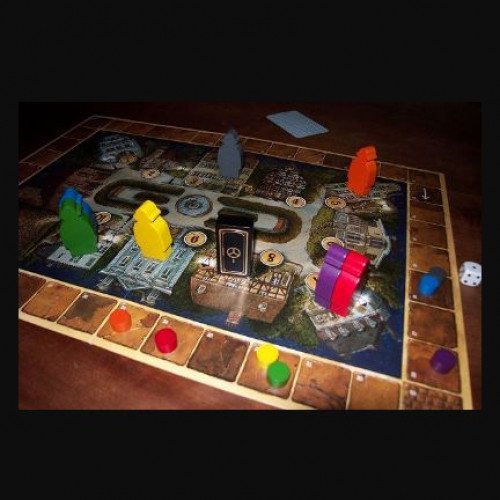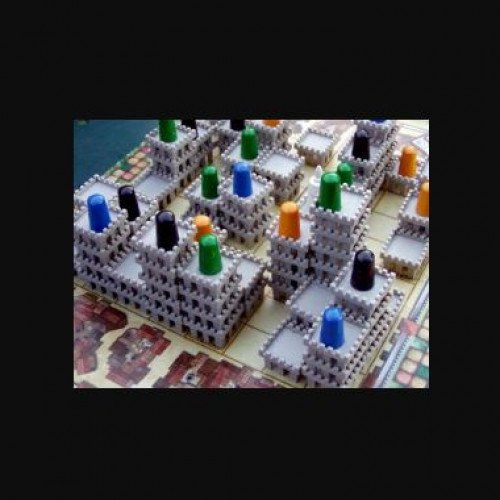"TOP SECRET SPIES" vs "TORRES"

TOP SECRET SPIES
Top Secret Spies (German name: Heimlich & Co.) is a spy-themed German-style board game designed by Wolfgang Kramer and published in 1984 by Ravensburger. The game, also known as Under Cover or Detective & Co, won the Spiel des Jahres award in 1986. The object of the game is to score the most points, while not revealing which colour you are until the end. It requires good bluffing and analytical skills. 7 colours are used, and there can be up to 4 "robot" colours moving around. On their turn a player rolls a die and can move any number of pieces a total number of spaces that adds up to the number on the die. This can result in a score, and the game continues until one player reaches 129+ points. At this time all players make secret guesses as to which player is which colour (gaining +5 points at the end of the game for each correct answer). The game ends when a spy reaches 142+ points, and then a winner is determined after guess points are added. In a 1990 interview, Kramer revealed that Heimlich & Co. was not one of his personal favourites.
Statistics for this Xoptio

TORRES
Torres is a German-style board game designed by Wolfgang Kramer and Michael Kiesling and published in 1999 by FX Schmid in German and by Rio Grande Games in English. The game strongly influenced Kramer and Kiesling's Mask Trilogy of games, but is not considered to be a part of the trilogy. The game has since been reprinted (in 2005). Game play revolves around constructing an abstract set of castles set on a grid. Each player is allotted several knight pieces, which are placed within the castles. The higher the knights' placement during a scoring round, the greater the payoff for the controlling player. The number of points a player receives per phase is based on the height times the surface area of the highest point of the castle that the knight is standing upon. If the knight is on the 3rd level of a castle, and the castle occupies 5 squares on the board, the player receives 15 points. A King piece is also placed on the board and acts as a bonus modifier to any knights that occupy the same level and castle as the King at the end of a phase. The game is composed of three different phases, with each phase having three to four rounds each depending on the number of players. Each player has five action points (AP) to spend during a round. The following moves may be performed during a round: Place a new knight (2 AP) All new knights must be adjacent to existing knights, and may only occupy a level equal to or lower than the existing knight on the board. Place a new castle piece (1 AP) Castle pieces must be placed next to or on top of existing castle pieces. A castle's level cannot exceed the surface area, i.e., a castle occupying two squares on the map may only reach two levels in height. New castle pieces may not join two existing castles. Pick up an action card (1 AP) There are 40 different action cards which allow the player to perform special moves, such as moving the King piece, moving castle pieces, or moving knights diagonally. In the master version, each player begins with a full set of action cards in their hand. Purchasing an action card is no longer a possible action. Move a knight (1 AP/square) Knights may move one square per AP point spent, but may only move up one level, and may not move diagonally. Knights can go down any number of levels without spending AP. Gain one victory point (1 AP) Action points may be exchanged for victory points on a one-to-one basis. Players receive three or four stacks of castle pieces per phase with two or three pieces per stack, depending on the current phase and number of players. A player may only use pieces from one stack per phase, but may transfer unused pieces to another stack for the next phase. After the last phase is reached all unused castle pieces are returned to the common supply and points are calculated. The king gives a bonus of five, ten, or fifteen points based on the scoring phase. The number of victory points per player is kept by individual markers on the edge of the game board. Since no two markers can occupy the same victory point number, the last player to occupy the space will automatically be moved ahead by one victory point. The person in last place after each scoring phase may then move the King piece to another castle. After the third phase, all victory points are calculated and the person with the highest number of points wins the game.